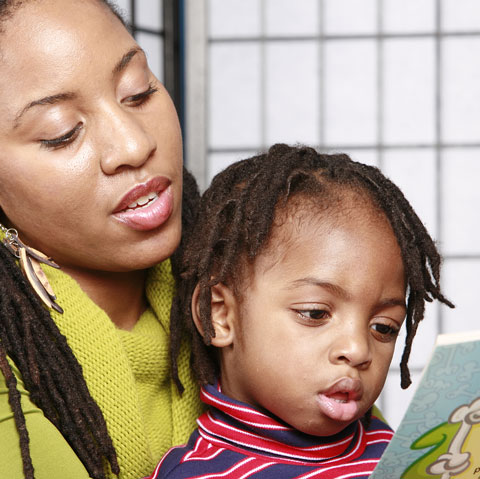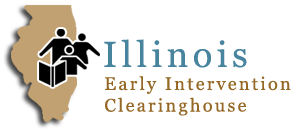Language Development in Young Children
This topical guide will introduce you to important books, videos, and information resources available from the EI Clearinghouse and other sources. Contact us via online form or by phone (1-877-275-3227) to request a resource listed below (or ask your local public librarian). Note that some videos may be viewed online, and journal titles will take you to the publisher’s homepage.
Table of Contents

EIC Resources
This topical guide will introduce you to important books, videos, and information resources about sign language that are available from the EI Clearinghouse and other sources.
Books
This book is for the father who thinks he is short on time. It provides ideas to use to connect with their child/ children in ways that engages both parties, and ways to interact and learn from one another as they participate in tools built on promoting communication and activity.
This book provides practical, effective tools to teach your baby relevant signs such as “more,” “all done,” “milk,” and others, all while having fun.
Using trusted American Sign Language (ASL), this book is the go-to guide for parents, caregivers, and educators looking to create effective two-way communication.
This short book has activities and games to further language development in an easy and fun way.
Based in cutting edge research in neuroscience, education, and the principles of attachment-based teaching, this important guide for parents offer tools and practices to help children transcend language-based learning difficulties, do better in school, and gain self-confidence and self-esteem.
This guide shows parents how to help their child communicate through talking during daily activities.
This book offers an introduction to the study of children’s acquisition and development of language from a generative/universal grammar-based theoretical perspective, providing comprehensive coverage of children’s acquisition.
With step-by-step written instructions for tons of FUN and easy-to-implement activities, parents and professionals can be confident in their ability to successfully identify and then strengthen these 11 major skills that encompass all the important social, cognitive, receptive, and expressive milestones that verbal and communicative kids have mastered.
This book provides caregivers and parents with over 55 activities that are designed to enrich children’s speech and language abilities.
With expert guidance and specific instructions and numerous examples, you will learn how to appropriately stimulate and catapult your toddler’s communication.
This easy-to-read book shows parents how to talk to and play with children in ways that support their emerging language skills.
This book has activities to promote language through imitation, turn taking, and shared fun.
This book teaches you how to stimulate speech using everyday play. It makes learning to talk fun and engaging for your child using easy-to-follow activities.
This audio book answers questions about language development that many parents have. It addresses many topics like language acquisition, expected milestones, etc., and it informs on how to enhance language and communication.
This book explains how yoga can help children develop language skills. There are various yoga strategies for multiple levels of speech development. Speech therapists and parents can use this resource.
Videos and Media
The videos discuss how to help infants and toddlers develop early literacy skills. The user’s guide explains how to use the videos in professional development and family workshops.
This companion to the It Takes Two to Talk book provides video examples of activities parents and professionals can use to develop the language and communication skills of young children. Includes video examples of children at each stage of early language development, from those who communicate non-verbally to those who have begun to use short sentences. Presents the accounts of two mothers of children with language delays and their participation in The Hanen Program for Parents.
This observation of preschoolers shows them engaged in activities that exemplify the extraordinary advancements in language and literacy that children make at this age.
Ideas for new parents using conversation for learning.
Learn simple strategies for working with children with receptive language delays and their families. Receptive language milestones and characteristics of children with receptive language delays/disorders are reviewed. Strategies are demonstrated in numerous video clips with toddlers in order to teach parents/caregivers to improve receptive language skills at home and in daily routines. An easy tag line is introduced to teach parents how to cue a child with receptive language delays. Considerations for children with language delays are discussed with emphasis on helping a child learn to understand words before he’s expected to comply with behavioral expectations during this early developmental period of 9 to 21 months.
Learn simple strategies for working with children ages 2 to 4 with receptive language delays and their families. Goals and milestones are outlined with activities demonstrated in numerous video clips with young children. An easy tag line is introduced to teach parents how to cue a child with receptive language delays. Considerations for children with language delays are discussed with emphasis on helping a child learn to understand words before he’s expected to comply with behavioral expectations during this early developmental period. A review of ‘best practices’ for behavioral modification for children birth to 4 is provided. Clinicians will be able to use this information as the basis for parent/caregiver education with families of the individual children on their caseloads or for group training programs.
Organizations
ASHA is a professional association for speech-language pathologists and audiologists. This site contains numerous resources, including topic-specific guides, continuing education opportunities, ASHA publications, articles, an online store, and the latest research. ASHA Special Interest Groups were created to promote specific professional interests among members, develop communication and networking in diverse professional settings, identify and convey concerns and needs to the Association’s governance, and assist in policy formation.
Reach Out & Read Illinois prepares children for kindergarten and strengthens the bond between a child and their caregiver by incorporating books into pediatric visits from six months to five years, connecting families to neighborhood resources, and encouraging families to read together. Children’s Book Lists are available also.
Professional organization for parents, educators, and speech-language pathologists to help young children learn and develop language. Offers programs for parents to help their children.
info@hanen.org or 1-877-426-1225
Articles
The purpose of this article is to describe family coaching strategies and their implementation features to teach parents to incorporate specific NT strategies into their family routines and activities
This article describes a language intervention model that includes 4 components: interest-based child learning opportunities, the everyday family and community activities that are sources of interest-based child learning, the methods for increasing child participation in the everyday learning activities, and the use of responsive teaching for promoting child communication and language learning while children are engaged in the activities.
This article provides tips for parents and caregivers on play activities that promote early literacy and that can be incorporated into natural environments. Available as a PDF.
This article explains how play is beneficial to language development and how adults need to help guide children in play that has learning benefits. Available as a PDF.
The purpose of this article is to explore recommended practices in choosing and using key word signs (i.e., simple single-word gestures for communication) to facilitate first spoken words in hearing children with language delays.
Web Resources
This page offers age-appropriate ways that parents can engage their young children to help develop speech and language abilities.
This free toolkit details communication skills that parents should expect to see in their child by age and tips for how to support children’s development through daily reading. PDFs also in Spanish.
This page describes communication skills and milestones and provides examples of activities for caregivers to support a child’s communication development.
ASHA’s Identify the Signs campaign educates about typical communication development as well as the early warning signs of speech, language, and hearing disorders.
Exploring the sounds of language is an important part of learning how to read and write. Spend time listening, talking, and reading together to build your child’s skills and confidence. These games will help your child begin to demonstrate an understanding of spoken words, syllables, and sounds. Also available in Polish, Korean, Chinese, Arabic, and French.
Young children are developing their ability to express themselves through language. You can help your child build vocabulary and conversation skills by talking together. Also available in Polish, Korean, Chinese, Arabic, and French.
It’s happening again! You’re running errands with your children and suddenly you’re stuck—in traffic, at the clinic, in the checkout line. Many parents find that playful learning activities can help reduce children’s impatience when they have to wait.
This guide will take you through disorders for which speech, language, or communication issues are a component and offer resources that you can use to educate yourself on how speech therapy can help your child.

